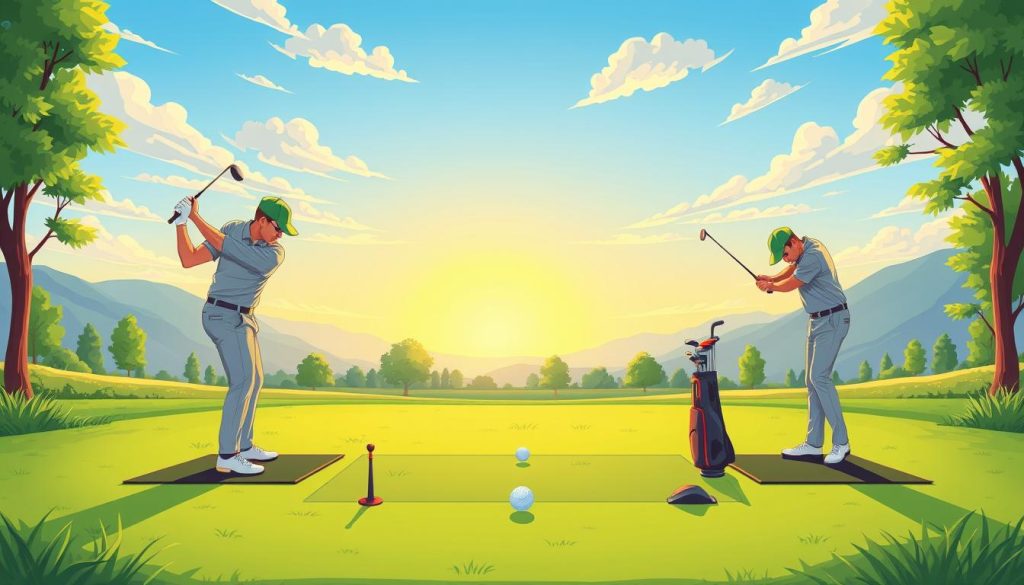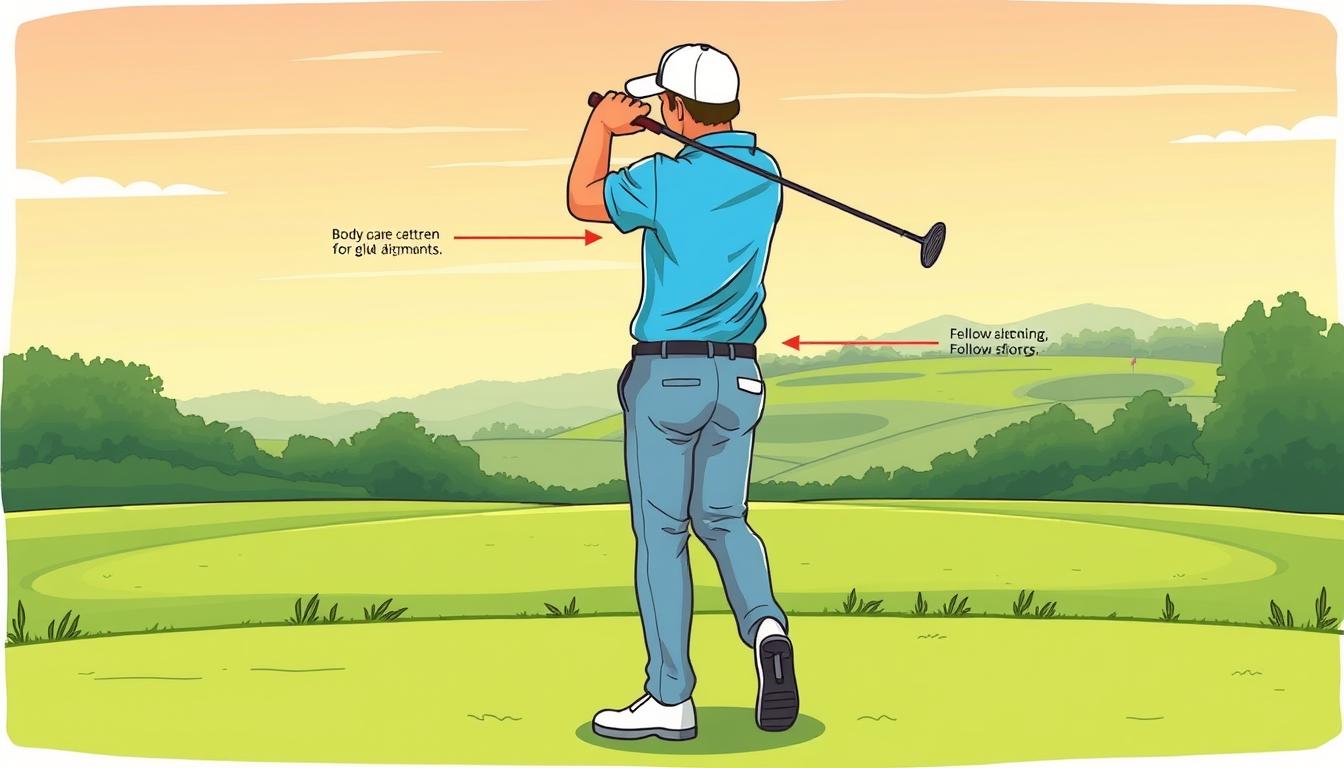Golf swing lessons are key to improving your game. They are essential whether you’re just starting or want to refine your skills. This guide will cover the basics of golf swing mechanics and share tips for beginners.
Mastering the golf swing begins with the right grip, stance, and alignment. These are the basics of a strong swing. As you get better, you’ll learn about the swing’s four phases: takeaway, backswing, downswing, and follow-through. Each phase is important for consistency, power, and accuracy.
Getting lessons from a pro can help fix common swing issues like slicing or hooking. Regular practice and the right tools will help you stick to good habits. This will boost your performance on the course.
Key Takeaways
- Proper grip, stance, and alignment are fundamental to a good golf swing
- The four phases of the swing are takeaway, backswing, downswing, and follow-through
- Professional lessons can help identify and correct common swing faults
- Regular practice is essential for improvement
- Training aids can reinforce good habits and enhance performance
Understanding Golf Swing Fundamentals
Golf swing fundamentals are key to playing well. Learning these basics can really boost your game. Let’s explore the essential elements for a solid golf swing.
Proper Stance and Posture
Your stance is vital for a good swing. Stand with your feet shoulder-width apart, knees bent, and weight balanced. This stance helps you swing smoothly and powerfully. About 70% of golfers need help with their swing at some point.
Athletic Position Basics
Being in an athletic posture improves your swing. Keep your back straight and lean forward from your hips. This posture gives you a stable base and helps with weight transfer. Imagine a line from your club grip to your trail shoulder for better alignment.
Ball Position Guidelines
The ball’s position changes with the club. For drivers, it’s even with the inside of your lead foot. With shorter clubs, it’s closer to your center. This helps with better contact and control for various shots.
| Club Type | Ball Position | Stance Width |
|---|---|---|
| Driver | Inside lead foot | Shoulder width |
| Irons | Center to forward | Slightly narrower |
| Wedges | Center | Narrow |
By mastering these swing fundamentals, you’ll improve a lot. Simplifying your swing thoughts can greatly improve your game. Regular practice will make a big difference on the course.
Mastering the Golf Grip
Your golf grip is the key to a great swing. Knowing the different grip types and techniques can really boost your game. Let’s look at the three main grip techniques to help you find the right one for you.
Baseball Grip Technique
The baseball grip, also known as the ten-finger grip, is perfect for beginners. Hold the club like you would a baseball bat, with all ten fingers. This grip is comfy and can lower hand tension. It’s ideal for those with arthritis or new to golf.
Overlap Grip Method
The overlap grip, or Vardon grip, is a favorite among pros. Put the pinky finger of your trailing hand between the index and middle fingers of your lead hand. This grip helps hands work together better and can improve control. It suits players with larger hands or longer fingers.
Interlock Grip Approach
The interlock grip involves linking the pinky of your trailing hand with the index finger of your lead hand. Tiger Woods likes this grip for its secure hold. It’s great for golfers with smaller hands, helping prevent the club from twisting during your swing.
Choosing the right golf grip technique depends on your hand size, comfort, and playing style. Try out these grip types to see what works best for you. Remember, a good grip is key for consistent and powerful swings.
The Four Phases of Golf Swing Mechanics
Understanding the golf swing phases is key to bettering your game. Let’s explore the four main stages of golf swing mechanics that shape every shot.
The golf swing has four main phases: takeaway, backswing, downswing, and follow-through. Each phase is crucial for a smooth, powerful, and accurate shot.
- Takeaway: This initial movement sets the tone for your entire swing.
- Backswing: Here, you rotate your body and club to build potential energy.
- Downswing: The power phase where you transfer energy to the ball.
- Follow-through: Completes the swing and ensures proper ball flight.
Recent studies show that 80% of golf instructors stress the importance of optimal posture in these phases. Proper execution of each stage greatly improves your performance.
| Swing Phase | Key Focus | Common Mistake |
|---|---|---|
| Takeaway | One-piece movement | Breaking wrists too early |
| Backswing | Shoulder rotation | Swaying instead of turning |
| Downswing | Lower body initiation | Casting the club |
| Follow-through | Full body rotation | Stopping short of finish |
Mastering these golf swing phases leads to a more consistent and effective swing. Remember, practice and patience are essential for improving your golf swing mechanics.
Golf Swing Lessons Guide
Taking golf swing lessons can really boost your game. This guide will show you how to find the best golf instruction. It will help you get the most out of your learning.
Finding the Right Instructor
Finding the right golf teacher is key. Look for someone with good credentials and a teaching style that fits you. Many now offer online lessons, so you can learn from anywhere.
Lesson Frequency and Duration
How often and long you take lessons depends on your goals and schedule. Beginners might need weekly lessons. More experienced players might prefer bi-weekly or monthly sessions. Lessons usually last from 30 minutes to an hour.
| Skill Level | Recommended Frequency | Typical Duration |
|---|---|---|
| Beginner | Weekly | 45-60 minutes |
| Intermediate | Bi-weekly | 60 minutes |
| Advanced | Monthly | 60-90 minutes |
Setting Achievement Goals
Set clear, measurable goals for your golf lessons. This could be to lower your handicap, learn new techniques, or improve your game. Keep track of your progress and change your goals as you go. This will keep you motivated and focused.
- Improve driving distance by 10 yards
- Reduce number of putts per round
- Master the proper grip technique
- Develop a consistent pre-shot routine
Remember, golf instruction is a journey. With the right lessons and practice, you’ll see your swing and game improve steadily.
Essential Golf Swing Training Aids
Golf training aids can really change the game for you. They add structure and purpose to your practice. This can boost your performance on the course. Let’s look at some key categories of golf swing training aids that can improve your technique.
Alignment Tools and Devices
Alignment is key for a consistent golf swing. Tools like alignment sticks help you set up right. Place them parallel to your target line for proper body alignment.
Some golfers use laser guides for visual feedback on their aim. These aids can greatly improve your accuracy over time.
Swing Path Trainers
Swing path trainers focus on your swing mechanics. The “Lag Shot” is a popular choice. It helps you feel the correct swing path and tempo.
These trainers often have weighted heads or flexible shafts. They strengthen your golf muscles and promote a more effective swing path. Regular use can lead to a more consistent and powerful swing.
Video Analysis Equipment
Video analysis is a powerful tool for golf swing analysis. Many smartphones now have slow-motion video capabilities. You can record your swing and review it frame by frame.
This visual feedback is invaluable for identifying areas of improvement. Some golf training aids even include built-in cameras for instant replay and analysis.
Remember, the key to success with golf training aids is consistent use. Choose aids that address your specific needs and integrate them into your regular practice routine. With dedication and the right tools, you can see significant improvements in your golf game.
Weight Transfer and Body Rotation
Mastering golf swing weight transfer and body rotation is key to improving your game. These elements are the base of a strong and precise swing. Let’s explore the main points of weight transfer and body rotation to boost your technique.

Weight transfer in golf means moving your body weight from your back foot to your front foot during the downswing. This move is crucial for power and balance in your swing. Studies reveal that proper weight transfer can boost your swing efficiency by up to 14%.
To achieve effective weight transfer:
- Begin with a neutral weight distribution at setup
- Shift about 75-80% of your weight to your back foot at the top of your backswing
- Move at least 70% of your weight to your front foot during the downswing
Body rotation is essential for power and balance. As you rotate your body in the backswing, your hips and shoulders turn away from the target. Then, during the downswing, your body uncoils, sending energy through the club to the ball.
To improve your body rotation:
- Focus on rotating your shoulders fully during the backswing
- Start the downswing with your lower body
- Let your hips lead the rotation towards the target
Practice drills can help you perfect your weight transfer and rotation. Try slow, controlled swings to make the right movements a habit. Training aids like pressure plates can give you feedback on your weight distribution during the swing.
Keep in mind, a wider stance can cause too much head movement during weight transfer. Aim for a stance width about two inches wider than your hips for better balance and weight shift. With regular practice, you’ll see your power and accuracy on the course improve.
Common Swing Faults and Corrections
Golf swing faults can really hurt your game. It’s key to know what they are and how to fix them. Let’s look at some common swing faults and how to correct them.
Slicing Solutions
A slice makes the ball curve from left to right for right-handed golfers. This happens when the clubface is open at impact. To fix a slice, aim to close the clubface and swing on an inside-out path.
Practice rotating your forearms through impact. This helps square the clubface.
Hooking Remedies
Hooking makes the ball curve too much to the left. It’s usually caused by a closed clubface at impact. To correct a hook, keep the clubface square and swing slightly outside-in.
Also, check your grip. A strong grip can lead to hooking.
Balance Issues
Keeping balance in your swing is key for consistent play. Many struggle with balance, causing unpredictable shots. To improve, focus on your stance and how you distribute your weight.
Stand with your feet shoulder-width apart. Try to keep your weight evenly on both feet.
| Golf Swing Fault | Cause | Correction |
|---|---|---|
| Slicing | Open clubface at impact | Close clubface, inside-out swing path |
| Hooking | Closed clubface at impact | Square clubface, outside-in swing path |
| Balance Issues | Poor stance and weight distribution | Shoulder-width stance, even weight distribution |
Fixing golf swing faults takes time and effort. Be patient and make small, steady improvements. With hard work, you’ll see your game get better.
Practice Drills and Exercises
Improving your golf game takes hard work and focused practice. Golf drills and swing exercises are key to sharpening your skills. Let’s look at some effective drills to boost your game.
Swing Plane Drills
Getting the swing plane right is vital for consistent shots. Use alignment sticks or a doorframe to practice your swing path. Set up the sticks to guide your club, keeping it on the right plane. Keep your body movements smooth and controlled as you focus on maintaining the proper angle throughout your swing. Incorporate golf swing rotation techniques to ensure your hips and shoulders turn cohesively, generating both power and accuracy. Regular practice with these tools can help ingrain the correct mechanics into your muscle memory for improved performance on the course.

Tempo Training
A consistent rhythm is essential for a smooth swing. Practice by counting “one” on the backswing and “two” on the downswing. This drill helps you keep a steady pace and avoid rushing your shots.
Impact Position Practice
The impact moment is crucial in golf. Use an impact bag to practice your club position at contact. Hit the bag as if it were a ball. This drill helps you feel the right position of your hands, arms, and body at impact.
Regular practice of these drills will improve your swing and overall game. As Travis Burkybile, a certified S&C coach with over 10 years of experience, says, consistent training is vital for stability, strength, and power in golf.
Conclusion
Golf swing improvement is a journey that needs dedication, patience, and practice. Golf lessons help you improve your technique, stance, and grip. You’ll find that mastering the golf swing is a lifelong journey.
There’s no single way to achieve the perfect golf swing. You might prefer a hands and arms method, a single plane swing, or a rotational technique. The most important thing is to find what works for you.
Golf lessons do more than teach technique. They also teach you to adapt to different courses and improve your shot-shaping skills.
As you get better, focus on key areas like the transition from backswing to downswing. Also, work on using your lower body for power and improving your impact position. Use training aids and practice drills to get better.
With hard work and a commitment to learning, you’ll see big improvements in your game. Each round will become more enjoyable and rewarding.
FAQ
What are the fundamental elements of a proper golf stance?
What are the three main types of golf grips?
What are the four phases of a golf swing?
How often should I take golf swing lessons?
What are some effective golf swing training aids?
How can I improve my weight transfer during the golf swing?
What causes a slice in golf, and how can I fix it?
What are some effective practice drills for improving my golf swing?
How can video analysis help improve my golf swing?
What should I look for when choosing a golf instructor?
Source Links
- https://nationalgcla.com/the-basics-of-the-golf-swing/
- https://swingtrainer.com/blogs/instruction/golf-swing-basics?srsltid=AfmBOopDFjCokulIlSCTX_qn3oCOO38Sg-rxDhLoabjVnZwnJQHn3NND
- https://thegolfrooms.com/the-beginners-guide-to-golf-lessons
- https://swingtrainer.com/blogs/instruction/golf-swing-basics?srsltid=AfmBOopP-43I8VG79yNVziup-OFjz9KJN7KtSGlBUW5btqSBNz0pANCE
- https://skillest.com/blog/a-comprehensive-guide-to-mastering-the-golf-swing/
- https://theleftrough.com/golf-swing-basics/
- https://www.golftec.courses/post/mastering-the-basics-understanding-and-perfecting-your-golf-grip
- https://www.golfmonthly.com/videos/golf-swing-tips/step-by-step-guide-to-the-perfect-golf-grip
- https://www.performancegolf.com/blog/how-to-grip-a-golf-club-step-by-step-method-for-beginners?srsltid=AfmBOopfPzyyBFGPmW6xYQnKcpiDmE-fKouU5oxz4rOKRhU-k4F-Byge
- https://lilyfieldphysio.com.au/blog/uncategorized/mastering-golf-swing-step-by-step-guide/
- https://www.ncbi.nlm.nih.gov/pmc/articles/PMC9227529/
- https://swingtrainer.com/blogs/instruction/golf-swing-basics?srsltid=AfmBOoovQL3dinKihy7ntnMADbDZHYNih7RnI3zyMmr1RcTR6oBECIuU
- https://swingtrainer.com/blogs/instruction/golf-swing-basics?srsltid=AfmBOop7MO7BwvMv8mFMIZHM_KoQDQs0EHCmuTBy0y4fzOd9-HdS2fpU
- https://elitegolfofco.com/beginners-guide-to-golf-understanding-the-key-components-of-golf-lesson-plans/
- https://hittingitsolid.com/blogs/news/golf-instruction-online-the-definitive-guide-2021-update
- https://practical-golf.com/golf-training-aids
- https://wholeinonebar.com/blogs/articles/the-ultimate-guide-to-golf-training-aids-do-they-help
- https://www.golftrainingaids.com/pages/instruction?srsltid=AfmBOoqmvJZVlSB2NZQIERUkdGFA4_lD5bJUGRlXvCtRdTfqS_5oA6mc
- https://rotaryswing.com/golf-instruction/golfbiomechanics/weight-shift-golf-swing
- https://whygolf.com/blogs/whysguyscorner/weight-shift-in-golf-swing?srsltid=AfmBOorAromxju2Mh3dQ9wdIxA3VhjqAmigsuGXu-9LecDpWaunvqVuI
- https://rotaryswing.com/golf-instruction/golfbiomechanics/weight-shift
- https://hackmotion.com/common-golf-swing-mistakes/
- https://collegeofgolf.keiseruniversity.edu/the-biggest-mistakes-you-are-making-with-your-golf-swing/
- https://gravesgolf.com/common-fault-and-fix-casting-the-club/
- https://www.trainheroic.com/blog/building-power-and-speed-for-your-golf-swing/
- https://devereuxgolf.com/blogs/live-proper-blog/golf-drills-for-beginners?srsltid=AfmBOopLiFNh5ameQM5ylXNj3DaWK6ET27-YBPI8LKu3SCFIpJ-FuF1H
- https://www.rvcc.com/blog/mastering-your-golf-swing
- https://swingfit.net/golf-swing-methods/


